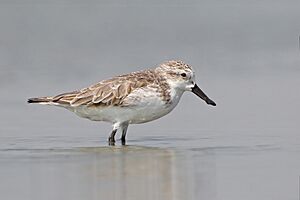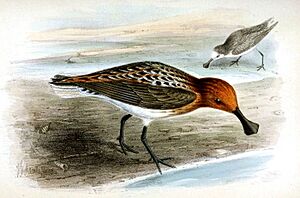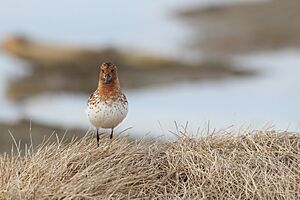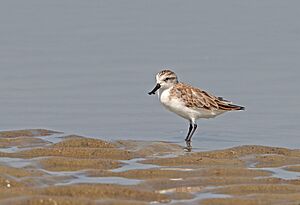Spoon-billed sandpiper facts for kids
The spoon-billed sandpiper (Calidris pygmaea) is a small bird that lives near water, often called a wader. It breeds along the coasts of the Bering Sea and flies south to spend winter in Southeast Asia. This bird is in great danger, and its numbers have dropped a lot since the 1970s. By the year 2000, there were only about 350 to 500 breeding birds left.
Quick facts for kids Spoon-billed sandpiper |
|
|---|---|
 |
|
| non-breeding | |
 |
|
| breeding | |
| Conservation status | |
| Scientific classification | |
 |
|
| Synonyms | |
|
Contents
What Does the Spoon-billed Sandpiper Look Like?
The most special thing about this bird is its spoon-shaped bill. When it's breeding, the adult bird has a reddish-brown head, neck, and chest with dark stripes. Its back is dark with light brown edges.
When it's not breeding, the bird loses its reddish color. Its upper parts become pale brownish-grey. The feathers on its wings have whitish edges. Its belly is white, and its legs are black. This bird is about 14 to 16 centimeters (about 5.5 to 6.3 inches) long.
The spoon-billed sandpiper makes quiet preep sounds or a sharp wheer. When the male bird is trying to attract a mate, it sings a buzzing, falling trill that sounds like preer-prr-prr. During this song, the male flies in a special way, hovering briefly, circling, and diving fast.
Where Do Spoon-billed Sandpipers Live?
The spoon-billed sandpiper breeds on the sea coasts and nearby land of the Chukchi Peninsula in Russia. It also breeds south along the Kamchatka Peninsula.
For winter, these birds migrate along the Pacific coast. They fly through Japan, Korea, and China. Their main winter homes are in south and southeast Asia. They have been seen in places like India, Bangladesh, Burma, Thailand, and the Philippines.
In March 2024, a spoon-billed sandpiper was seen in the Balanga, Bataan mudflat in the Philippines.
How Do Spoon-billed Sandpipers Behave?
This bird feeds by moving its bill from side to side as it walks forward with its head down. It builds its nests in June and July in coastal areas of the tundra. They choose grassy spots near freshwater pools.
Spoon-billed sandpipers eat moss found in the tundra. They also eat small animals like mosquitoes, flies, beetles, and spiders. Sometimes, they eat sea creatures such as shrimp and worms.
Protecting the Spoon-billed Sandpiper
This bird is critically endangered, which means it's very close to extinction. There are probably fewer than 1,000 adult birds left. The biggest dangers to its survival are losing its homes where it breeds. It also loses the muddy areas it uses during its migration and in winter.
A very important resting place for these birds in South Korea, called Saemangeum, has already been partly destroyed. Other wetlands there are also in danger. Studies show that up to 65% of key spoon-billed sandpiper homes in China, South Korea, and North Korea have been lost. A study in 2010 suggested that hunting in Burma is a main reason for the bird's decline.
Some protected areas for these birds include Yancheng in China and Mai Po Marshes in Hong Kong. In India, Point Calimere and Chilka lake also protect them. In 2016, there were only about 240 to 456 adult spoon-billed sandpipers left.
Because its numbers were dropping so fast, the IUCN changed its status to Critically Endangered in 2008. Some thought the population was only 120 to 200 pairs in 2009–2010. This showed an 88% drop since 2002.
Helping the Spoon-billed Sandpiper
In November 2011, thirteen spoon-billed sandpipers were brought to the Wildfowl and Wetlands Trust (WWT) reserve in Slimbridge, Gloucestershire, United Kingdom. The goal was to start a breeding program there. These birds hatched from eggs collected in remote parts of Russia. They spent 60 days in a special safe area in Moscow Zoo before their long journey.
This program, called headstarting, involves raising the chicks in a safe place. This helps more of them survive, from less than 25% to over 75%. Also, taking the eggs encourages the parents to lay a second set of eggs. In 2019, almost ten years after the rescue, the first two birds were born in the UK program. In 2013, conservationists hatched twenty chicks in Chukotka, Russia.
An education kit has been created to teach people about the bird and about protecting nature. It's available in several languages and is used in countries where the bird lives.
The Photo Ark
In July 2022, National Geographic announced that the spoon-billed sandpiper was the 13,000th animal photographed for The Photo Ark. This project aims to photograph every species in the world's zoos and wildlife sanctuaries.
Images for kids









